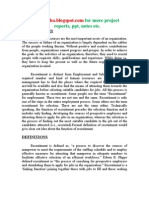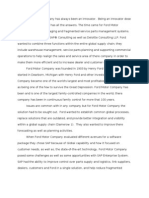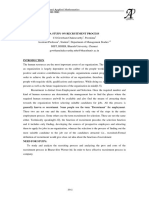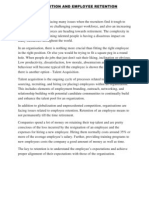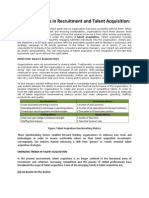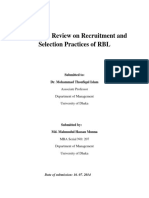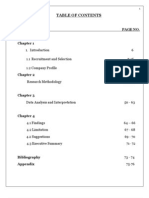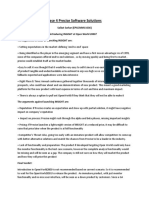Synopsis Recruitment and Selection in Real State Sector: A Case Study of DLF
Synopsis Recruitment and Selection in Real State Sector: A Case Study of DLF
Uploaded by
Kusum SinghCopyright:
Available Formats
Synopsis Recruitment and Selection in Real State Sector: A Case Study of DLF
Synopsis Recruitment and Selection in Real State Sector: A Case Study of DLF
Uploaded by
Kusum SinghOriginal Title
Copyright
Available Formats
Share this document
Did you find this document useful?
Is this content inappropriate?
Copyright:
Available Formats
Synopsis Recruitment and Selection in Real State Sector: A Case Study of DLF
Synopsis Recruitment and Selection in Real State Sector: A Case Study of DLF
Uploaded by
Kusum SinghCopyright:
Available Formats
SYNOPSIS Recruitment and Selection in Real State Sector: A case study of DLF
Submitted for the Award of Degree of Master in Business Administration BY KUSUM SINGH Enrollment No. 090239
UNDER THE SUPERVISION OF DR. AKSHAY SATSANGI DEPARTMENT: MANAGEMENT FACULTY: SOCIAL SCIENCE
DAYALBAGH EDUCATIONAL INSTITUTE (DEEMED UNIVERSITY)
DAYALBAGH, AGRA U.P SESSION -2013
INTRODUCTION
Hiring Employment has undergone a transformational change post recession. Trends and Issues in recruitment and selection have taken paradigm shift with market gradually recovering from slowdown .The effect of recession has brought new challenges for the companies as well as job aspirants. The phase marked by layoffs and pink slips, now seems to be getting over, opening new opportunities for the job seekers. At the same time, taking advantage of an improving economy, employers are planning to recruit new employees in their organization in near future while maintaining their talent pool. Recruitment, selection theory is based on an organization's accomplishment of hiring valuable employees, constituting a major function of human resource department. Recruitment process involves a systematic procedure from sourcing the candidates to arranging and conducting the interviews and requires many resources and time. The recruitment process is immediately followed by the selection process i.e. the final interviews and the decision making, conveying the decision and the appointment formalities. Hiring activities need to be responsive to the ever-increasingly competitive market to secure suitably qualified and capable recruits at all levels. Interventions, as defined in Van Tiem, Mosley, and Dessinger are deliberate, conscious acts that facilitate change in performance (p. 62). In applying the Human Performance Technology (HPT) model, after determining the gap in current versus desired performance and the likely causes of this gap, the next step is to decide on interventions or solutions to help resolve or improve performance problem(s). Within the Intervention Selection and Design step falls performance support, which considers both instructional and non-instructional interventions. In this paper, I will discuss one viable non-instructional intervention that organizations can implement to improve performancebetter recruitment and selection of human capital. Recruiting and selecting the right person for the job is vital to the success of organizations. In fact, Van Tiem et al. (2000) states, Finding desirable candidates is the number one employment challenge (p. 14). Other related challenges in this area include:
Retaining desirable employees Decreasing staff turnover Increasing qualified applicant pool Freeing up supervisors time spent coaching and training low-performing employees
Decreasing expenses related to additional training for training low-performing employees, as well as for frequent new hire training expenses resulting from turnover Minimizing grievance and legal procedures in the event a employee is fired
The solution to these challenges, including an improved hiring success rate for organizations starts with a well-defined recruitment and selection process. When this process is precisely defined and consistently implemented, it can not only increase the chances of hiring the right people up front, but also assist in promoting and reassigning people based on their personal repertory (knowledge and skills, capacity, and motives/motivation). Gilberts Behavioral Engineering Model (BEM) suggests that it costs less to change environmental supports (data, instruments and incentives) within an organization than to change a person's personal repertory (knowledge, capacity and motives).
RECRUITMENT
Recruitment is defined as a process to discover the sources of manpower to meet the requirements of the staffing schedule and to enjoy effective measures for attracting that manpower in adequate numbers to facilitate effective selection of an efficient workforce. Edwin B. Flippo defined recruitment as the process of searching for prospective employees and stimulating them to apply for jobs in the organization. In simple words recruitment can be defined as a linking function joining together those with jobs to fill and those seeking jobs.
SELECTION
Selection is usually a series of hurdles or steps. Each one must be successfully cleared before the applicant proceeds to the next one. The time and emphasis place on each step will definitely vary from one organization to another and indeed, from job to job with the same organization. The sequence of step may also vary from job to job and organization and organization. For example some organization may give more importance to testing while others give more emphasis to interviews for lower level position, while applicants for managerial jobs might be interviewed by a number of people.
TRENDS IN HUMAN RESOURCE
The role of the Human Resources Department has changed dramatically over the past 30 years and will become increasingly more strategic in nature in the future, said a leading light of the HR community in the recent 2006 Annual Conference and Exposition of HR practitioners in Washington, DC. Rita Craig, president of the Craig Group and a long-time professional HR consultant, said the role of HR has changed from a primarily administrative position to one that is more strategic. Times certainly have change from those days when the HR department was called the "smile and file" department since in that era, the primary qualifications for HR were simply a friendly disposition and an ability to file. She said that the emerging trends in HR call for HR professionals to take the lead in planning for the future and becoming strategic business partners in their organizations. She identified several other trends in the industry, as follows: (1) a shrinking talent pool, (2) An increase in outsourcing, (3) A more intense focus on work/life balance; (4) Changing workplace demographics, (5) Greater need for talent management, (6) Ethics requirements, and (6) Globalization. But the key appears to be strategic planning. With the changing landscape of Human Resources management in the years to come, strategic planning will be the key for HR to meet those needs and to succeed. The key to HR planning for the future begins with one simple question that HR professionals have to ask themselves, says Craig: "If we are successful in the years to come, what will our customers and competitors be saying about us?" With the answers to this question, HR practitioners can formulate a clear, shared vision and a sense of direction for the organization.
LATEST TRENDS IN RECRUITMENT AND SELECTION
OUTSOURCING
In India, the HR processes are being outsourced from more than a decade now. A company may draw required personnel from outsourcing firms. The outsourcing firms help the organization by the initial screening of the candidates according to the needs of the organization and creating a suitable pool of talent for the final selection by the organization. Outsourcing firms develop their human resource pool by employing people for them and make available personnel to various companies as per their needs. In turn, the outsourcing firms or the intermediaries charge the organizations for their services
Advantages of outsourcing are:
Company need not plan for human resources much in advance. Value creation, operational flexibility and competitive advantage. Turning the management's focus to strategic level processes of HRM Company is free from salary negotiations, weeding the unsuitable resumes/candidates. Company can save a lot of its resources and time.
POACHING/RAIDING
Buying talent(Rather than developing it) is the latest mantra being followed by the organizations today. Poaching means employing a competent and experienced person already working with another reputed company in the same or different industry; the organization might be a competitor in the industry. A company can attract talent from another firm by offering attractive pay packages and other terms and conditions, better than the current employer of the candidate. But it is seen as an unethical practice and not openly talked about. Indian software and the retail sector are the sectors facing the most severe brunt of poaching today. It has become a challenge for human resource managers to face and tackle poaching, as it weakens the competitive strength of the firm.
E- RECRUITMENT
Many big organizations use Internet as a source of recruitment. E- Recruitment is the use of technology to assist the recruitment process. They advertise job vacancies through worldwide web. The job seekers send their applications or curriculum vitae i.e. CV through e mail using the Internet. Alternatively job seekers place their CVs in worldwide web, which can be drawn by prospective employees depending upon their requirements.
Advantages of E-Recruitment are: 1) Low cost. 2) No intermediaries 3) Reduction in time for recruitment. 4) Recruitment of right type of people. 5) Efficiency of recruitment process
NEED OF THE STUDY
Human resources professionals often struggle to obtain the resources they need to effectively manage people in the workplace, and the difficulties that they face are augmented when economic conditions worsen. The current global recession has caused most companies to review their allocations of resources more critically and as a result, organizations of varying sizes have laid off a significant number of workers at all skill levels.
OBJECTIVES OF THE STUDY
To identify the changing trends in hiring pattern of employees in DLF. To identify the consequences of new hiring models in practice in DLF.
LITERATURE REVIEW
A review of avail literature was dine in order to understand how todays HR firms offer a wide variety of services to companies that need to focus on their core business activities and still establish and maintain good HR policies and to explore the factors that affect the HR outsourcing decision with special emphasis on a paper cost benefit analysis of HR outsourcing decision with special emphasis on a paper cost benefit analysis of HR outsourcing. Wright. Patrick ,(1999) professor of HR studies at Cornell University (Ithaca, N.Y.). The expectation is that the quality of service gets better, but theres no qualitative data out there to support the actual decision saying that outsourcing is always cheaper and better.1 Ulrich (1998), said that core activities are transformational work that creates unique value for employees, customers, and investors. Noncore activities would be transactional work that is routine and standard and can be easily duplicated and replicated.2 Hall and Torrington (1998) said that recruitment and selection were likely HR activities to be outsourced, either because they were considered noncore or because the organization lacked the expertise to handle them internally.3
RESEARCH METHODOLOGY
DATA COLLECTION PRIMARY DATA The source of collecting the primary data is QUESTIONNAIRE- Both by collecting responses through online mailing of the questionnaire. SECONDARY DATA The source of collecting the secondary data will be Internet, books on related issues, Case study, and Journals relevance to our study. SAMPLE SIZE : 50 employees from DLF. SAMPLE AREA The sample area chosen is DLF(Delhi). SAMPLING TOOL : QUESTIONNAIRE. SAMPLING TECHNIQUE: Stratified sampling technique. STATISTICAL TOOLS: The statistical tools used for analysis of the data, collected through questionnaire. Bar Graphs Pie Diagram
PROPOSED CHAPTER PLAN 1. Introduction 2. Review of literature 3. Research methodology 4. Analysis and findings 5. Conclusions and suggestions
REFRENCES
1.Wright. Patrick, professor of HR studies at Cornell University The expectation is that the quality of service gets better (Ithaca, N.Y.) (1999) 2.Ulrich that core activities are transformational work that creates unique value for employees, customers, and investors (1998). 3. Hall and Torrington recruitment and selection were likely HR activities to be outsourced (1998).
You might also like
- Recruitment & Selection Process Project ReportDocument39 pagesRecruitment & Selection Process Project Reportkamdica80% (41)
- Hack Recruiting: The Best of Empirical Research, Method and Process, and DigitizationFrom EverandHack Recruiting: The Best of Empirical Research, Method and Process, and DigitizationNo ratings yet
- Human Resource Management: RecruitmentDocument7 pagesHuman Resource Management: RecruitmentKiwoolNo ratings yet
- Harvard Business Review on Finding & Keeping the Best PeopleFrom EverandHarvard Business Review on Finding & Keeping the Best PeopleRating: 5 out of 5 stars5/5 (1)
- Strengthening The Moral Mooring Safeguarding AssetDocument3 pagesStrengthening The Moral Mooring Safeguarding AssetJannahSalazar100% (1)
- Examples of Examination Questions: Multiple ChoiceDocument12 pagesExamples of Examination Questions: Multiple ChoiceSreekanth NagloorNo ratings yet
- SAP Company Case Study Ford-FinalDocument3 pagesSAP Company Case Study Ford-FinalcdavisgirlNo ratings yet
- Acquiring Human Resource 001002Document250 pagesAcquiring Human Resource 001002anandhugs67% (3)
- Recruitment ProcessDocument23 pagesRecruitment ProcessLiyaqath Ali100% (4)
- HRM Research Article CIA 1Document11 pagesHRM Research Article CIA 1Apoorv GoelNo ratings yet
- Visit For More Project Reports, PPT, Notes Etc.: in TR Odu CT IonDocument39 pagesVisit For More Project Reports, PPT, Notes Etc.: in TR Odu CT IonPriyanka PuniaNo ratings yet
- Recruitment WriteupDocument24 pagesRecruitment WriteupKumar AnshumanNo ratings yet
- Human Resource Management - Set 2.1Document33 pagesHuman Resource Management - Set 2.1sam NathNo ratings yet
- " A Comparative Study of Recruitment & Selection, Training and Development Policies in Indian Mncs and Foreign M..Document16 pages" A Comparative Study of Recruitment & Selection, Training and Development Policies in Indian Mncs and Foreign M..AKANKSHA PREETINo ratings yet
- Unit 3 Human Resource Management Task 1Document13 pagesUnit 3 Human Resource Management Task 1AimenWajeeh100% (1)
- Get The Right People 9 Critical Design Questions For Securing and Keeping The Best HiresDocument24 pagesGet The Right People 9 Critical Design Questions For Securing and Keeping The Best Hiresfisuoy100% (1)
- A Study On Recruitment and Selection Process Organization With The Help of Recruiting AgencyDocument10 pagesA Study On Recruitment and Selection Process Organization With The Help of Recruiting AgencyHimanshi SharmaNo ratings yet
- D IshikaDocument41 pagesD IshikavipultandonddnNo ratings yet
- Get The Right People WP PDFDocument24 pagesGet The Right People WP PDFMDNo ratings yet
- Sachin ReportDocument80 pagesSachin Reportpruthvimgowda1997No ratings yet
- CH 4 - 1Document13 pagesCH 4 - 1wubeNo ratings yet
- Recruitment ProcessDocument22 pagesRecruitment Processsidsriram376No ratings yet
- Dhathri Project - CompletedDocument94 pagesDhathri Project - CompletedDhathri. vNo ratings yet
- Reward System Research PaperDocument13 pagesReward System Research Paperparris123No ratings yet
- Talent Acquisition and Employee RetentionDocument7 pagesTalent Acquisition and Employee RetentionSagar U R DostNo ratings yet
- Effective Recruitment and Selection As A Tool For Achieving Higher Employee Productivity in An OrganizationDocument11 pagesEffective Recruitment and Selection As A Tool For Achieving Higher Employee Productivity in An OrganizationMehreenNo ratings yet
- Recruitment ProcessDocument54 pagesRecruitment ProcessAmit PasiNo ratings yet
- Emerging Trends in Recruitment and Talent AcquisitionDocument3 pagesEmerging Trends in Recruitment and Talent Acquisitionpallavi1289No ratings yet
- HRM Final ProjectDocument35 pagesHRM Final ProjectNidhi NirmalNo ratings yet
- Selection Process 03Document23 pagesSelection Process 03Kushan SamararatneNo ratings yet
- External RecruitmentDocument3 pagesExternal RecruitmentNeri dacanayNo ratings yet
- HR-Recritment & Selection ToyotaDocument82 pagesHR-Recritment & Selection ToyotaAbdul Azeez ShaikNo ratings yet
- Recruitmentandselectionprocesssynopsis 140822092720 Phpapp01Document12 pagesRecruitmentandselectionprocesssynopsis 140822092720 Phpapp01Subrat PatnaikNo ratings yet
- SYNOPSIS REPORT by NikDocument12 pagesSYNOPSIS REPORT by NikAshu GusainNo ratings yet
- Recruitment and Selection Process Impact of MNC IndustryDocument15 pagesRecruitment and Selection Process Impact of MNC Industrysssmp HRNo ratings yet
- HRM Assignment Final - Tata MotorsDocument16 pagesHRM Assignment Final - Tata MotorsAbhi_The_RockstarNo ratings yet
- Thesis Report On Recruitment and Selection ProcessDocument6 pagesThesis Report On Recruitment and Selection ProcessNat Rice100% (2)
- IJNRD2310213Document15 pagesIJNRD2310213abhaybhamaniNo ratings yet
- Preethi Concelia .VDocument46 pagesPreethi Concelia .VCool TamilNo ratings yet
- 3Document78 pages3Harshitha ReddyNo ratings yet
- HRM ProjectDocument32 pagesHRM ProjectshwetambarirupeshNo ratings yet
- Rec and SelectionDocument20 pagesRec and SelectioniamonlyoneNo ratings yet
- A STUDY ON RECRUITMENT AND SELECTION TRENDS IN IT & ITES AT ALLWIN - 18 10 19-2.odtDocument65 pagesA STUDY ON RECRUITMENT AND SELECTION TRENDS IN IT & ITES AT ALLWIN - 18 10 19-2.odtsri rNo ratings yet
- Literature Review On Recruitment and Selection Practices of RBLDocument7 pagesLiterature Review On Recruitment and Selection Practices of RBLzurriyashaNo ratings yet
- Seminar Kaziranga UniversityDocument20 pagesSeminar Kaziranga UniversityTy GravesNo ratings yet
- A Focused Analysis of Recruitment and Performance Management in The Import and Export Industry PDFDocument9 pagesA Focused Analysis of Recruitment and Performance Management in The Import and Export Industry PDFxolilevNo ratings yet
- The Role of Recruitment and Selection Strategies in Supporting Employee Retention Within A Complex International Labour MarketDocument11 pagesThe Role of Recruitment and Selection Strategies in Supporting Employee Retention Within A Complex International Labour MarketTom Jacob80% (5)
- Recruitment & Selection in StarupDocument72 pagesRecruitment & Selection in StarupYashNo ratings yet
- Recruitment SelectionDocument45 pagesRecruitment SelectionKhushbu Jindal71% (7)
- INTRODUCTION TO HUMAN RESOURCE-yamahaDocument25 pagesINTRODUCTION TO HUMAN RESOURCE-yamahamahesh_khebade50% (2)
- Literature Review On Recruitment and SelDocument7 pagesLiterature Review On Recruitment and SelKelly JongNo ratings yet
- Anglais L3 FinanceDocument10 pagesAnglais L3 FinanceRomaric YapoNo ratings yet
- Human Resource AuditDocument39 pagesHuman Resource AuditFarica Arradaza ZgamboNo ratings yet
- The ACE Advantage: How Smart Companies Unleash Talent for Optimal PerformanceFrom EverandThe ACE Advantage: How Smart Companies Unleash Talent for Optimal PerformanceNo ratings yet
- Examining Career Development within Learning Organisations: Career Development Book Series, #4From EverandExamining Career Development within Learning Organisations: Career Development Book Series, #4No ratings yet
- Reinventing Talent Management: Principles and Practics for the New World of WorkFrom EverandReinventing Talent Management: Principles and Practics for the New World of WorkNo ratings yet
- The Ultimate Employee Training Guide- Training Today, Leading TomorrowFrom EverandThe Ultimate Employee Training Guide- Training Today, Leading TomorrowNo ratings yet
- Learning and Development: How To Close The Skills Gap in Your OrganizationFrom EverandLearning and Development: How To Close The Skills Gap in Your OrganizationNo ratings yet
- Case 4 Precise Software SolutionsDocument3 pagesCase 4 Precise Software Solutionssaikat sarkarNo ratings yet
- Business Ethics: Fon Univerzitet Prv-Privaten-Univerzitet-Vo-R.M. Fakultet Za Primeneti Stranski Jazici I BiznisDocument15 pagesBusiness Ethics: Fon Univerzitet Prv-Privaten-Univerzitet-Vo-R.M. Fakultet Za Primeneti Stranski Jazici I BiznisTrajko GjorgjievskiNo ratings yet
- Universidad Del Istmo Facultad de Ciencias Económicas y Empresariales "MBO" Talento HumanoDocument5 pagesUniversidad Del Istmo Facultad de Ciencias Económicas y Empresariales "MBO" Talento HumanoluispradoarevaloNo ratings yet
- CHAPTER 2 A New Product DevelopmentDocument21 pagesCHAPTER 2 A New Product DevelopmentHakimi BobNo ratings yet
- Case Study 3 Abridged v.3Document13 pagesCase Study 3 Abridged v.3رهف العاليNo ratings yet
- Infor FMS SunSystemsDocument4 pagesInfor FMS SunSystemsDidik Hariadi100% (1)
- 150 Evolution of ManagementDocument60 pages150 Evolution of Managementbornifacemeleki10No ratings yet
- PMP Question With AnswersDocument10 pagesPMP Question With Answersvinjoseph9999No ratings yet
- Chap 4 R SCM CoyleDocument28 pagesChap 4 R SCM CoyleZeeshan QaraNo ratings yet
- Module 2. Unit 1. The Mission StatementDocument3 pagesModule 2. Unit 1. The Mission StatementRichard Jr RjNo ratings yet
- Application of SWOT Analysis To Justify The StrateDocument6 pagesApplication of SWOT Analysis To Justify The Strategorgo.incNo ratings yet
- Procedure - Preventive MaintenanceDocument2 pagesProcedure - Preventive MaintenanceJeff Drew0% (1)
- Expenditure Cycle Case - GARCIADocument3 pagesExpenditure Cycle Case - GARCIAARLENE GARCIANo ratings yet
- Lok Jack Faculty-BrochureDocument12 pagesLok Jack Faculty-BrochureMiller HarrisNo ratings yet
- Southwest Airlines Presentation FinalDocument37 pagesSouthwest Airlines Presentation FinalsparshsevenNo ratings yet
- Landor PRDocument38 pagesLandor PRtantalasNo ratings yet
- Senior High School Department: Subject Name: MKTG Subject Descriptive Title: Principles of MarketingDocument4 pagesSenior High School Department: Subject Name: MKTG Subject Descriptive Title: Principles of MarketingPavi Antoni VillaceranNo ratings yet
- Human Resourse Planning: Neha Joshi 008 Bba (Mom) Human Resource ManagementDocument10 pagesHuman Resourse Planning: Neha Joshi 008 Bba (Mom) Human Resource ManagementGaurav JainNo ratings yet
- Material Kanban KEPC enDocument121 pagesMaterial Kanban KEPC enCharlineNo ratings yet
- ROSPA Achievement Award Category GuideDocument4 pagesROSPA Achievement Award Category GuideOnaFajardoNo ratings yet
- Insight037 ProjectLogisticsDocument9 pagesInsight037 ProjectLogisticsSrushti JNo ratings yet
- SectionC Group6 FNAC DartyDocument5 pagesSectionC Group6 FNAC DartyAman SharmaNo ratings yet
- Crime Report SynopsisDocument10 pagesCrime Report Synopsisdawarevaishnavi1811No ratings yet
- Daddy Day Care: Scene Related Marketing Concept ApplicationDocument2 pagesDaddy Day Care: Scene Related Marketing Concept ApplicationLala AlalNo ratings yet
- Practice Questions Process CostingDocument68 pagesPractice Questions Process CostingJuan Dela Cruz IIINo ratings yet
- A&a Long TheoryDocument24 pagesA&a Long Theorya93903832No ratings yet
- Cost Concepts Behaviors and MeasurementsDocument47 pagesCost Concepts Behaviors and MeasurementsTricia Marie TumandaNo ratings yet

